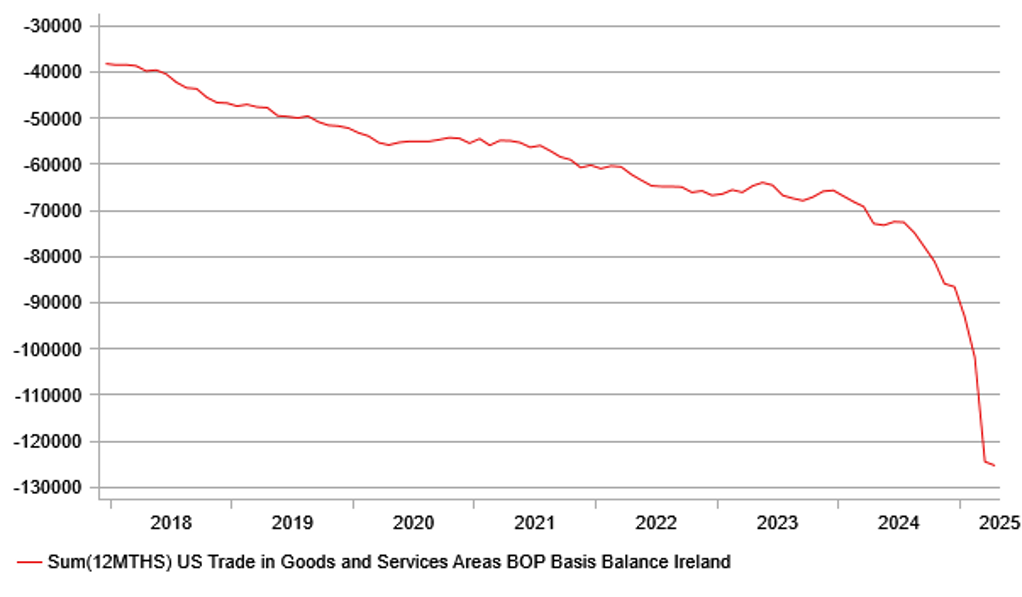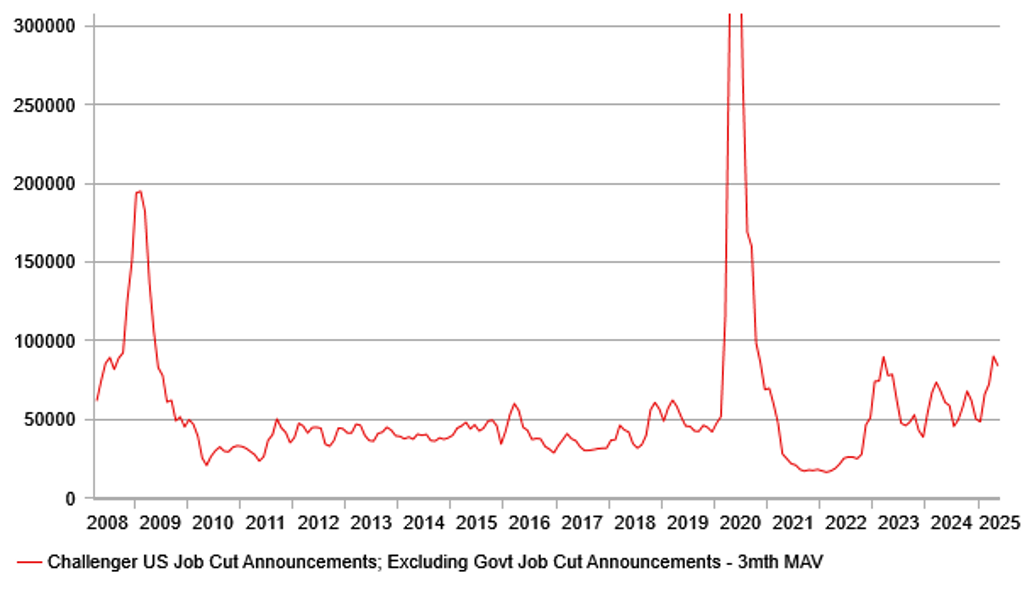Trade tensions ease but limited reaction ahead of US jobs data
USD: US-China call eases trade tensions further
The US dollar remains in a narrow trading range with the further easing of trade tensions between the US and China having limited impact – Presidents Trump and Xi held a 90-minute call although there was nothing concrete from the call other than President Trump stating that they were now “in very good shape” with China in regard to the trade deal. The follow-on was vague with further discussions to take place “shortly”. Given the unpredictable nature of trade negotiations in general and the volatile US-China relationship market participants have correctly not read too much into this initial dialogue. Still, it shifts the risks somewhat and the 2-year UST note yield ended 5-6bps higher. The major swing for the dollar followed the ECB meeting yesterday – which we covered here – and the guidance expressed by President Lagarde was more explicit than expected helping EUR/USD jump to a high just below the 1.1500-level, before the move retraced on the improved US-China trade outlook. We saw the ECB press conference communication as still consistent with further cuts but yesterday’s cut likely brings to an end seven cuts at consecutive policy meetings.
There has also been limited impact from the release of the semi-annual Macroeconomic and Foreign Exchange Policies of Major Trading Partners of the US report that concluded that no major trading partner had manipulated its currency versus the US dollar to gain a competitive advantage. The US uses three criteria to determine if a country manipulates its currency with countries meeting two of those criteria put on a list – the last report under President Biden had seven countries on the ‘watch list’ and yesterday, Ireland and Switzerland were added. For Ireland, its huge bilateral trade surplus with the US (over USD 15bn) and its substantial current account surplus (over 3% of GDP) were the two factors.
I think key going forward was the warning from the US Treasury that it was putting trading partners “on notice” of stricter analysis and more significant consequences of breaches in the future. China was criticised for a lack of transparency in its FX policy and the US called on Japan to tighten its monetary stance to help strengthen the yen. USD/JPY fell modestly initially after the report was released but has today rebounded highlighting the limited impact. We still suspect the US will continue to behave in a way that implies a desire for a weaker dollar which will continue to weigh on performance and help reinforce dollar depreciation ahead.
IRELAND ADDED TO US ‘WATCH LIST’ DUE TO SURGING TRADE IMBALANCE

Source: Bloomberg, Macrobond & MUFG GMR
USD: Jobs data in focus as weakening signs persist
The key macro event of the week is upon us with the non-farm payrolls data for May released this afternoon. The 177k increase recorded in April was larger than expected so the consensus is for a smaller 125k gain today. There has been resilience in the labour market beyond consensus expectations highlighted by the fact that the 6mth moving average of 193k is well above the 12mth average of 157k. A consensus 125k gain today would certainly underline expectations that the labour market may be softening but a consensus print would not be a bad enough print to see much shift in the consensus that the labour market is softening, but not dramatically.
The much weaker ADP gain, for two consecutive months, does raise the bar of a weaker NFP gain today – month-to-month ADP changes is not a reliable guide for NFP but two consecutive weaker prints does increase the prospect of a weaker NFP. The last time ADP employment gains were this weak over two months, the NFP gain slowed sharply from 306k to 85k (March 2023). The initial claims data is also signalling slowdown. The 247k increase in initial claims was the largest since October last year. Continuing claims fell modestly from last week’s level but averaged over the two weeks, continuing claims are at the highest since November 2021. The pick-up in continuing claims is an indication that those losing their jobs are finding it more difficult to get new employment quickly, highlighting weakening labour market conditions. The Challenger Job Cut Announcements was also released yesterday and when government job cut announcements are excluded (DOGE-related volatility) the private sector job cuts are elevated at levels around the highs not seen since covid.
The offset to these data sets is that sentiment in general has improved since the US-China trade de-escalation was announced in Geneva on 12th March. The consumer confidence data for example saw the 6mth expectations of fewer jobs being available declining back to the level from February. The ISM Services Employment index jumped for the second consecutive month to 50.7. The ISM Manufacturing Employment index remains weak below the 50-level but did also increase for the second consecutive month. So a smaller NFP gain seems likely but equally a big deterioration seems unlikely as well given the improving sentiment. The S&P 500 closing at the highest level since February and 20% above the closing low in April will help as well.
We probably need to see a print below the 100k to get the market moving and for pricing on a July FOMC rate cut to increase further. The probability of a July rate cut has increased modestly this week and a soft print would increase expectations of Fed Chair Powell being more open on signalling a July cut at the FOMC press conference on 18th June. But for that we would likely also need a tick higher in the unemployment rate and slower wage growth – both feasible. US dollar sentiment remains poor and hence further weakness seems more likely and a break of the 98-level and the April lows would likely trigger renewed momentum selling.
CHALLENGER JOB CUT ANNOUNCEMENT (EX-GOVT; 3MTH AVG) ARE ELEVATED CLOSE TO HIGHS NOT SEEN SINCE GFC (EXCLUDING COVID)

Source: Bloomberg, Macrobond & MUFG GMR
KEY RELEASES AND EVENTS
|
Country |
BST |
Indicator/Event |
Period |
Consensus |
Previous |
Mkt Moving |
|
EC |
09:00 |
ECB's Holzmann speaks |
-- |
-- |
-- |
!! |
|
EC |
09:30 |
ECB's President Lagarde speaks |
-- |
-- |
-- |
!!! |
|
EC |
10:00 |
Employment Change (QoQ) |
Q1 |
0.3% |
0.1% |
! |
|
EC |
10:00 |
GDP (QoQ) |
Q1 |
0.3% |
0.2% |
!! |
|
EC |
10:00 |
Retail Sales (MoM) |
Apr |
0.2% |
-0.1% |
! |
|
EC |
10:00 |
Retail Sales (YoY) |
Apr |
1.4% |
1.5% |
! |
|
US |
13:30 |
Nonfarm Payrolls |
May |
127K |
177K |
!!!!! |
|
US |
13:30 |
Private Nonfarm Payrolls |
May |
110K |
167K |
!! |
|
US |
13:30 |
Unemployment Rate |
May |
4.2% |
4.2% |
!!!!! |
|
US |
13:30 |
Average Hourly Earnings (MoM) |
May |
0.3% |
0.2% |
!!!! |
|
US |
13:30 |
Average Hourly Earnings (YoY) |
May |
3.7% |
3.8% |
!! |
|
US |
13:30 |
Average Weekly Hours |
May |
34.3 |
34.3 |
! |
|
US |
13:30 |
Government Payrolls |
May |
-- |
10.0K |
! |
|
US |
13:30 |
Participation Rate |
May |
-- |
62.6% |
!! |
|
US |
13:30 |
U6 Unemployment Rate |
May |
-- |
7.8% |
!! |
|
CA |
13:30 |
Employment Change |
May |
-11.9K |
7.4K |
!! |
|
CA |
13:30 |
Avg hourly wages Permanent employee |
May |
-- |
3.5% |
! |
|
CA |
13:30 |
Participation Rate |
May |
-- |
65.3% |
! |
|
CA |
13:30 |
Unemployment Rate |
May |
7.0% |
6.9% |
!! |
|
US |
15:00 |
Fed Governor Bowman speaks |
||||
|
US |
20:00 |
Consumer Credit |
Apr |
11.30B |
10.17B |
! |
Source: Bloomberg & Investing.com
